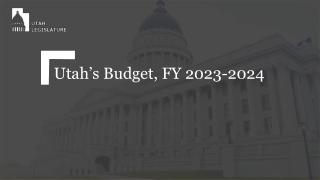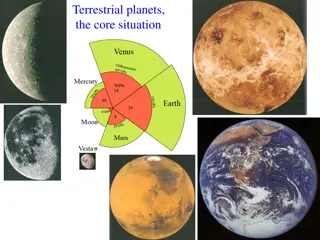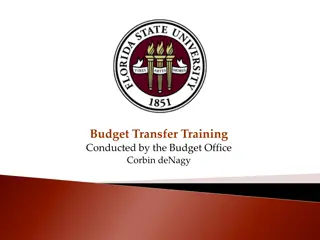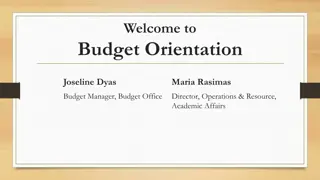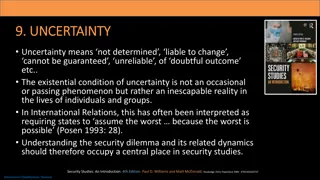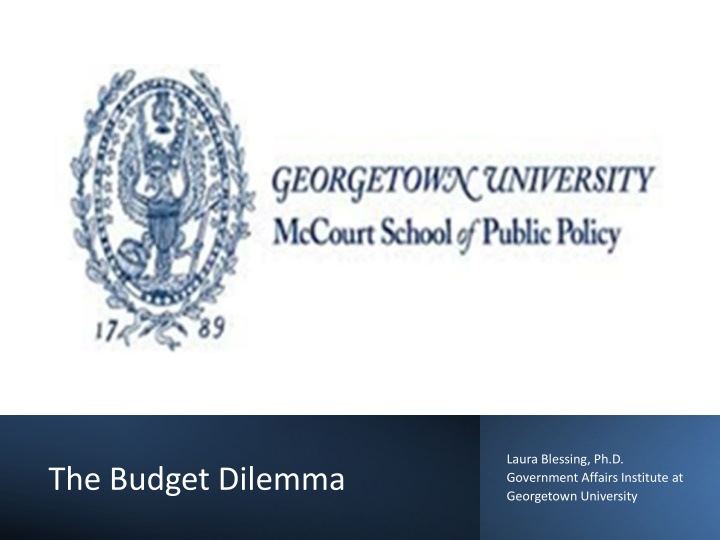
The Budget Dilemma: Historical Deficits and Future Projections
Explore the complex dynamics of the budget dilemma, major historical deficits, debt projections, and key legislative acts shaping fiscal policy. Learn how political parties, voters, laws, and external events impact budget decisions. Gain insights into the Budget Act of 1974 and significant statutory developments post-1974, including pandemic spending, tax reforms, and stimulus packages.
Download Presentation

Please find below an Image/Link to download the presentation.
The content on the website is provided AS IS for your information and personal use only. It may not be sold, licensed, or shared on other websites without obtaining consent from the author. If you encounter any issues during the download, it is possible that the publisher has removed the file from their server.
You are allowed to download the files provided on this website for personal or commercial use, subject to the condition that they are used lawfully. All files are the property of their respective owners.
The content on the website is provided AS IS for your information and personal use only. It may not be sold, licensed, or shared on other websites without obtaining consent from the author.
E N D
Presentation Transcript
Laura Blessing, Ph.D. Government Affairs Institute at Georgetown University The Budget Dilemma
I. What is the Budget Dilemma? Source: CBO, March 2024, Long-Term Budget Outlook
Whodunit? Political parties Voters Congressional procedure Laws already passed Outside events (esp emergencies) Other factors?
A few different ways of looking at historical deficits & debt: Annual Deficits, 1969-2029 Projections before Covid Source: CBO Budget & Economic Outlook, 2019-2029 Jan 2019
Current Annual Deficit Projections (CBO May 2023)
Source: CBO May 2023 Debt as a percentage of economy each year, reaching 118 percent of GDP by 2033 which would be the highest level ever recorded. Debt would continue to grow beyond 2033 if current laws generally remained unchanged.. Feb 2023 CBO: Debt held by the public is projected to rise in relation to the size of the GDP of GDP from 2023 to 2033 and are the main contributor to the growth of total deficits. Primary deficits decrease by 0.1 percent of GDP over that period. May 2023 CBO: In CBO s updated projections, net interest outlays increase by 1.1 percent
Post-WWII to 1974: fragmented & no formal process (yet: generally good outcomes until the early/mid-1970s). Budget Act of 1974: limits impounding creates the CBO creates the modern budget process, with budget committees in each chamber (centralizing the budget process and creating the reconciliation procedure) 2. How Did We Get Here? The 1974 Budget Act
Major statutory developments since 1974 Omnibus Budget Reconciliation Act of 1993 (referred to as the Deficit Reduction Act of 1993) (Clinton tax raise) Pandemic spending (2020 $2.1 T CARES Act, 2021 $1.9T American Recovery Act are largest ones) Tax Reform Act of 1986 (Reagan tax reform, designed as revenue neutral) Recovery Act (American Recovery and Reinvestment Act of 2009: stimulus spending) Fiscal cliff: after 1 day expiration, most of Bush tax cuts extended Economic Recovery Tax Act of 1981 (Reagan tax cut) 1981 1986 1993 2009 2 Jan. 2013 2020- 1985 1990 2001 2011 2017 Omnibus Budget Reconciliation Act of 1990 (Bush tax raise) and Budget Enforcement Act (PAYGO) Bush tax cuts (2001 and 2003: largest, identified as the Bush tax cuts : 2001 EGTRRA, 2003: JGTRRA) Budget Control Act (sequestration ) Tax Cuts and Jobs Act (Trump tax cut) Gramm- Rudman- Hollings (sequestration , reaffirmed in 1987)
Congress has a math problem (CBO May 2023)
3. Another angle: changing composition of federal spending over time
4. Is the debt a problem we have to fix? CBO March 2024 (showing growing interest costs)
These can be tough choices both in terms of good policy and in terms of what s possible politically. Smaller fixes early on make later choices easier, and there s no one silver bullet here. Let s talk about it! 5. What fixes exist?
A few resources https://rollcall.com/podcast/cq-budget-podcast/ CQ Budget Podcast: https://rollcall.com/podcast/cq-budget-podcast/ https://www.concordcoalition.org/ Concord Coalition: https://www.concordcoalition.org/ https://www.cbpp.org/ Center on Budget and Policy Priorities: https://www.cbpp.org/ https://www.crfb.org/ Committee for a Responsible Federal Budget: https://www.crfb.org/ https://bipartisanpolicy.org/ Bipartisan Policy Center: https://bipartisanpolicy.org/ https://www.brookings.edu/ The Brookings Institution: https://www.brookings.edu/ CRS, CBO, JCT, GAO
Updated figures with respect to top foreign nations holding US debt (Japan is #1) Source: CBO Budget & Economic Outlook, 2019-2029 Jan 2019
Spending and total debt historical patters, in dollar amounts (unadjusted), not vis- -vis GDP
(Revised considerations of baseline projections, continued) (CBO Feb 2023) The cumulative total deficit over the 2023 2032 period is $3.1 trillion larger in CBO s current baseline projections than it was in the agency s May 2022 projections, mainly because of newly enacted legislation and changes to the economic forecast that boost projected net interest outlays and spending on mandatory programs, such as Social Security.
Component pieces of initial pandemic legislation

